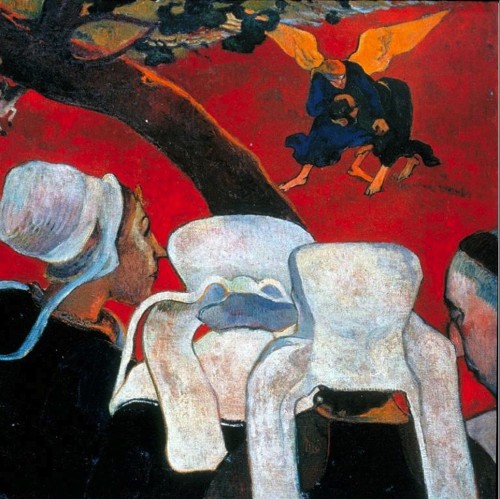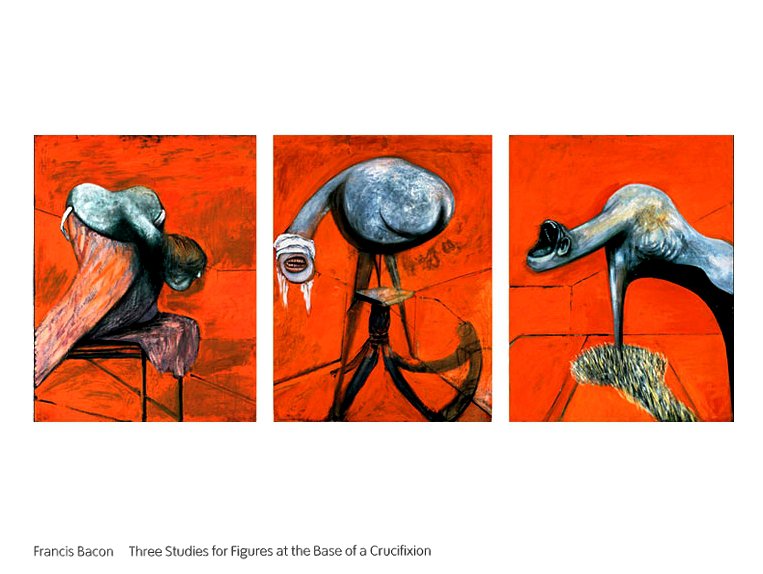

New!!: Three Studies for Figures at the Base of a Crucifixion and Canvas Ĭassandra or Kassandra (Ancient Greek: Κασσάνδρα, also Κασάνδρα), also known as Alexandra, was a daughter of King Priam and of Queen Hecuba of Troy in Greek mythology. New!!: Three Studies for Figures at the Base of a Crucifixion and Biomorphism Ĭanvas is an extremely durable plain-woven fabric used for making sails, tents, marquees, backpacks, and other items for which sturdiness is required. New!!: Three Studies for Figures at the Base of a Crucifixion and Battleship Potemkin īiomorphism models artistic design elements on naturally occurring patterns or shapes reminiscent of nature and living organisms. New!!: Three Studies for Figures at the Base of a Crucifixion and Atreus īattleship Potemkin (Бронено́сец «Потёмкин», Bronenosets Potyomkin), sometimes rendered as Battleship Potyomkin, is a 1925 Soviet silent film directed by Sergei Eisenstein and produced by Mosfilm.

In Greek mythology, Atreus (from ἀ-, "no" and τρέω, "tremble", "fearless", Ἀτρεύς) was a king of Mycenae in the Peloponnese, the son of Pelops and Hippodamia, and the father of Agamemnon and Menelaus. New!!: Three Studies for Figures at the Base of a Crucifixion and Armature (sculpture) In sculpture, an armature is a framework around which the sculpture is built. New!!: Three Studies for Figures at the Base of a Crucifixion and Apollo (magazine) New!!: Three Studies for Figures at the Base of a Crucifixion and Anthropomorphism Īpollo is an English-language monthly magazine covering visual arts of all periods, from antiquity to the present day. New!!: Three Studies for Figures at the Base of a Crucifixion and Anglo-Irish people Īnthropomorphism is the attribution of human traits, emotions, or intentions to non-human entities. New!!: Three Studies for Figures at the Base of a Crucifixion and Altarpiece Īnglo-Irish is a term which was more commonly used in the 19th and early 20th centuries to identify a social class in Ireland, whose members are mostly the descendants and successors of the English Protestant Ascendancy. New!!: Three Studies for Figures at the Base of a Crucifixion and Agamemnon Īn altarpiece is an artwork such as a painting, sculpture or relief representing a religious subject made for placing behind the altar of a Christian church. In Greek mythology, Agamemnon (Ἀγαμέμνων, Ἀgamémnōn) was the son of King Atreus and Queen Aerope of Mycenae, the brother of Menelaus, the husband of Clytemnestra and the father of Iphigenia, Electra or Laodike (Λαοδίκη), Orestes and Chrysothemis. New!!: Three Studies for Figures at the Base of a Crucifixion and Aeschylus 456/455 BC) was an ancient Greek tragedian. Expand index (8 more) » « Shrink index AeschylusĪeschylus (Αἰσχύλος Aiskhulos c. Eliot, Tate, The Family Reunion, The South Bank Show, Triptych, Wieland Schmied, William Bedell Stanford, World War II. ĥ8 relations: Aeschylus, Agamemnon, Altarpiece, Anglo-Irish people, Anthropomorphism, Apollo (magazine), Armature (sculpture), Atreus, Battleship Potemkin, Biomorphism, Canvas, Cassandra, Chthonic, Cimabue, Claude Monet, Clytemnestra, Colm Tóibín, Crucifixion, David Sylvester, Erinyes, Fiberboard, Fons et origo, Francis Bacon (artist), Graham Sutherland, Greek tragedy, Henry Moore, Hieronymus Bosch, Infrared, John Everett Millais, John Russell (art critic), Lefevre Gallery, List of Picasso artworks 1921–30, List of Picasso artworks 1931–40, Matthias Grünewald, Melvyn Bragg, Michael Peppiatt, Michel Leiris, Oil paint, Oil pastel, Oresteia, Pablo Picasso, Passion of Jesus, Potemkin Stairs, Predella, Raymond Mortimer, Sam Hunter, Second Version of Triptych 1944, Sergei Eisenstein, South Kensington, Surrealism.

Three Studies for Figures at the Base of a Crucifixion is a 1944 triptych painted by the Irish-born British artist Francis Bacon.


 0 kommentar(er)
0 kommentar(er)
